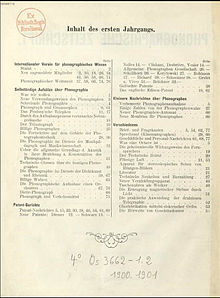Phonographic journal


The Phonographische Zeitschrift (PZ) was a magazine published in Berlin from 1900 to 1933 , temporarily with the subtitle Fachblatt for the entire music and speaking machines - industry / organ of the Reich Association of the German Speech Machine and Record Trade . In 1933, after the seizure of power and the introduction of the Volksempfänger , the title was initially Phonographische und Radio -Zeitschrift until 1935 , from 1936 and until 1938 then Phonographische, Radio- und Musikinstrumenten -Zeitschrift (PRZ).
Content and meaning
The Munich Digitization Center (MDZ) wrote about the importance of the periodical with a total of around 34,000 pages:
"[...] a unique source of text and images on phonography in the first third of the 20th century [...]. The PZ contains material of high informative value on the technical , repertoire and economic history of the phonographic industry and is highly relevant for issues relating to the history of music , media , culture , business and copyright . Because most of the German company archives of the sound carrier industry no longer exist in the last two world wars and afterwards as a result of extensive cassations , the information stored in the PZ cannot be replaced from any other source . As an industry journal , the PZ also contains lists of new releases for the record companies . These are an important source for the dating of historical industrial sound carriers, and they often specify the various label catalogs . "
digitalization
In 2014 there were not even two completely preserved complete editions of the journal available in the entire Federal Republic of Germany, and some of them were in a "precarious state of preservation". One of the reasons is, for example, the inferior paper used at the time of the First World War , during the subsequent German hyperinflation and other crises . For conservation purposes and for the purpose of further research , the surviving specimens were withdrawn from regular manual use. Instead, the holdings of the two owning libraries - the Berlin State Library - Prussian Cultural Heritage and the library of the Deutsches Museum in Munich - are to be virtually merged into a complete edition , which will then be available to the public online . As part of the ViFaMusik project, all volumes of the phonographic journal were digitized and some of them made available via the digital collections of the Munich digitization center. For copyright reasons, however, it is initially only about the first 21 years that are made publicly searchable.
history
For the Leipzig trade fair in 1928, a special issue of the PZ appeared on September 1 of that year.
Web links
- Phonographic journal (1900–1938). Presentation of the digitization project on digital-sammlungen.de
Individual evidence
- ↑ a b c d e Phonographic Journal (1900–1938). Presentation of the digitization project on digital-sammlungen.de
- ↑ Compare the further information from the German National Library
- ↑ On the digitization of the phonographic journal (1900–1938)
- ↑ Illustration of the illustrated title from Verlag Rothgiesser und Diesing AG - German Historical Museum Foundation